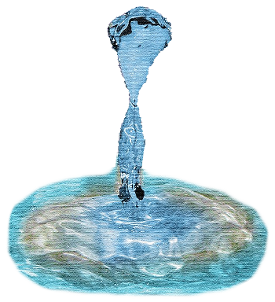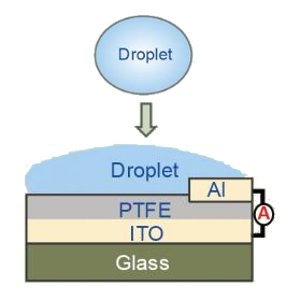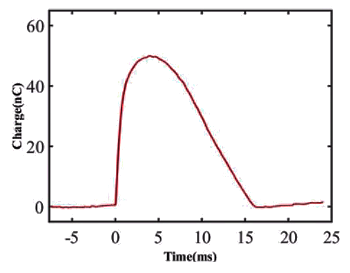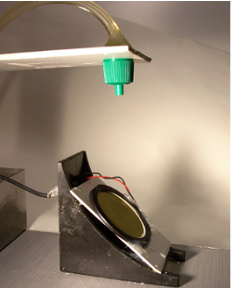Power from Raindrops
March 23, 2020
A
child's first encounter with the concept of
unintended consequences is likely the
nursery rhyme, "
Rain, rain, go away. Come again some other day." The "come again another day"
refrain is important, since we wouldn't want
rainfall to cease entirely. I once read a
short story in which a man who was granted
wishes was
annoyed at something, and
shouted, "Stop everything." This caused the
Earth's rotation to stop, throwing objects off our
planet's surface. While stopping the Earth's rotation would have been far more
disastrous than
depicted in the story, if we go down a few levels in (
classical)
physics, when
electrons would also stop their
orbits around the nucleus, etc., this would indeed be the end of the
universe, and a sudden end of the story.
In
Tikalon's northern New Jersey home, we're blessed with frequent
rains, and the occasionally unwelcome
tropical storm. While all this rain is good for
agriculture and replenishing our
water table, it might also be used as an
energy source. Many years ago, while unclogging a
gutter downspout at my house, I noticed the forceful
flow of
water that occurred when I removed the clog. A small
hydroelectric turbine at this downspout could
harvest the rainwater's energy.

The ocean covers about 71% of Earth's surface. The Earth's water cycle starts with the evaporation of ocean and sea water by solar radiation. As this water rises into the atmosphere, the lower temperatures at high altitudes cause the water to condense into small, buoyant, liquid water droplets in clouds. These droplets collide and merge, finally becoming heavy enough to fall as precipitation.
About a half million square kilometers of water falls annually as precipitation, about 20% of which falls over land.
(Wikimedia Commons image by jansku136).
This energy arising from the
gravitational potential difference between a
roof and the Earth's surface starts with the solar energy that evaporates water into the atmosphere to allow the rain. Unfortunately, a one inch rainfall onto the
area of my roof results in less than a tenth
kilowatt hour of power; and, rainfall is not a continuous
phenomenon. However, that amount of
power would light a useful
LED light bulb for an entire
night when there was a
electrical service disruption due to a storm.
Rain, of course, originates much higher than a roof level of 4-5
meters, so energy is lost in its
impact with the roof. in 2008,
scientists at the
French Atomic Energy Commission (Commissariat à l'énergie atomique),
Grenoble, France, decided to extract raindrop energy more directly. They harvested all the impact energy of raindrops using
piezoelectric materials.[1-2]
Their
research,
published in
Smart Materials and Structures, showed that a one
millimeter diameter rain drop, a smaller type found in
drizzle, has an impact energy of two
microjoules, the five millimeter droplets of a heavy rain have a millijoule of energy, while some rain droplets have more than ten millijoules of energy. The energy-harvesting is aided by the fact that most rain drops impact
inelastically; that is, they don't bounce.[1-2]
The
French scientists used one
mil (0.001 inch) thick
polyvinylidene fluoride polymer sheets as a piezoelectric energy-harvester, and about 1
microwatts of power was obtained by impact of for the smallest droplets, and more than 10
milliwatts for the largest.[1] They calculated that rainfall in
France would produce an average power of about one
watt-hour per
square meter.[1] This is still rather small, amounting to a little more than 200 watt-hours for my roof, but this might be a way to power remote
environmental monitoring instrumentation in
tropical rainforests.
There was an attempt in 2014 to replace piezoelectric energy harvesting of raindrops with
triboelectric nanogenerators which were self-cleaning,
robust, and easily
fabricated at low
cost.[3] These yielded a peak
power density of less than one watt per square meter.[3] More recently, a team of scientists from the
City University of Hong Kong (Hong Kong, China), the
University of Science and Technology of China (Hefei, China), the
University of Nebraska-Lincoln (Lincoln, Nebraska), the
University of Electronic Science and Technology of China (Chengdu, China), and the
Chinese Academy of Sciences (Beijing, China), did a further
optimization of the triboelectric approach.[4-5] Their research is reported in a recent issue of
Nature.[4]

Schematic diagram of the droplet-based electrical generator.
(City University of Hong Kong image.)
Their raindrop energy-harvesting device, as shown in the figure, consists of a
polytetrafluoroethylene (PTFE, Teflon)
film on an
indium tin oxide (ITO) substrate with an
aluminum electrode.[4] This
device architecture is similar to that of a
field-effect transistor, and it has a much higher high
energy conversion efficiency and power density than other triboelectric effect energy-harvesting architectures.[5] A falling water drop will spread over the surface of the device to bridge the electrode elements to release the developed
electrical charge.[4]
The instantaneous power density of this device is as high as 50.1 W/m
2, which is thousands times higher than other triboelectric raindrop energy-harvesters.[5] As water droplets continuously hit the PTFE, the generated surface charges accumulate to a
saturation point (see figure).[5] The charge generation and storage are done by the PTFE and ITO parts of the device, and the spreading water droplet bridges the
circuit to the aluminum electrode to create the
electrical voltage that becomes an
electrical current in an attached device.[5]

Temporal evolution of charge after droplet impact and subsequent spreading on the droplet-based electrical generator.
(Still image from a City University of Hong Kong video. Click for larger image.)
Says
Zhong Lin Wang of the Chinese Academy of Sciences and an
author of the paper describing this research, "Our research shows that a drop of 100
microlitres (1 microlitre = one-millionth
litre) of water released from a height of 15
cm can generate a voltage of over 140V. And the power generated can light up 100 small LED light bulbs."[5] This research was
funded by the
National Natural Science Foundation of China and the
United States National Science Foundation, among other sources.[5]
patent applications for this
invention have been filed in the US and
China.[5]
I published a short article on a triboelectric effect device in 2016.[6] I also enjoy doing simple
benchtop experiments using
household items available to me in my high-tech household with an
electronics workshop. Inspired by these raindrop energy-harvesters, I built a demonstrator that uses a
piezoelectric loudspeaker element. This loudspeaker is just a 1-3/4
inch diameter circular brass diaphragm, 0.005 inch thick, onto which is deposited a one inch diameter circular patch of lead-zirconate titanate (PZT) with a
silver electrode. The voltage generated is between the brass disk and the silver electrode.

My demonstration
apparatus, as shown in the
photograph (
click for larger image), has part of an
eye drop bottle connected to one liter
water reservoir at a higher height to produce a series of
droplets impacting on the
piezoelectric element. The dropper can be varied in height, and the piezoelectric element is
tilted at 45-degrees to allow the water to
flow away from it. The piezoelectric element was coated with a thin
oil film to promote
drainage. The generated
electrical voltages were sent to the
microphone input of a
desktop computer where
data acquisition was done using the
free and open source Audacity digital audio editor.
The droplet
rate was about one every 1.5
seconds, with about 25 drops per milliliter, and a
calculated drop diameter of 4
millimeters. Each drop caused the brass diaphragm to ring at its
resonant frequency of about 750
Hz, and this
pulse shape was easy to
model (see figure). The model allowed an accurate calculation of the power generated by each drop by
numerical integration, since the generated voltage was terminated in a 10,000
ohm resistance and the power
P is equal to voltage
E squared divided by the resistance
R (
P = E2/R).

The right image is the mathematical model of the electrical pulse produced by a water droplet striking a piezoelectric loudspeaker. The actual pulse is shown on the left. (Click for larger image.)
Of course, the peak voltage will increase as the drop height increases, as shown in the
graph. There's some drop-to-drop
variation, so the
data are somewhat coarse. The drop
velocity v at impact can be calculated from the simple
equation,
v = √(2 g h), where
g is the
gravitational acceleration, and
h is the height. At the highest height measured (480 mm), this velocity was 3.07 meters/second. It's good that raindrops have a
terminal velocity of about 9 meters/second, or
life on Earth might not have been possible. At our 480 mm height, the calculated energy per drop is 0.7
nanojoule.
Scaling to raindrop terminal velocity gives 2 nanojoules per drop for this simple
apparatus.

Peak voltage as a function of drop height.
The peak voltage follows a roughly linear trend from zero height to the maximum height of 480 mm possible on the apparatus. Drop-to-drop variation is responsible for the scatter, since the largest peak in a pulse series was determined automatically in Audacity.
References:
- Romain Guigon, Jean-Jacques Chaillout, Thomas Jager and Ghislain Despesse, "Harvesting raindrop energy: experimental study," Smart Materials and Structures, vol. 17, no. 1 (January 11, 2008), Article no. 015039, https://doi.org/10.1088/0964-1726/17/01/015039.
- Lisa Zyga, "Rain Power: Harvesting Energy from the Sky" (PhysOrg, January 22, 2008).
- Zong‐Hong Lin, Gang Cheng, Sangmin Lee, Ken C. Pradel, and Zhong Lin Wang, Harvesting water drop energy by a sequential contact-electrification and electrostatic-induction process. Adv. Mater., vol. 26 (July 14, 2014), pp. 4690-4696, doi:10.1002/adma.201400373
- Wanghuai Xu, Huanxi Zheng, Yuan Liu, Xiaofeng Zhou, Chao Zhang, Yuxin Song, Xu Deng, Michael Leung, Zhengbao Yang, Ronald X. Xu, Zhong Lin Wang, Xiao Cheng Zeng, and Zuankai Wang, "A droplet-based electricity generator with high instantaneous power density," Nature (February 5, 2020), https://doi.org/10.1038/s41586-020-1985-6.
- New droplet-based electricity generator: A drop of water generates 140V power, lighting up 100 LED bulbs, City University of Hong Kong Press Release, February 5, 2020.
- D.M. Gualtieri, "Simple, Novel Switch Exploits Triboelectric Effect," Electronic Design, June 3, 2016.
Linked Keywords: Child; unintended consequences; nursery rhyme; Rain, rain, go away. Come again some other day; refrain; precipitation (meteorology); rainfall; short story; wish; annoyance; annoyed; shout; Earth's rotation; planet; lithosphere; surface; disaster; disastrous; narration; depict; classical physics; electron; atomic orbital; orbit around the nucleus; universe; Tikalon; northern New Jersey; rain; Atlantic hurricane; tropical storm; agriculture; water table; sustainable energy; energy source; rain gutter; gutter downspout; fluid dynamics; flow; water; hydroelectricity; hydroelectric; electric generator; turbine; energy harvesting; ocean; water cycle; evaporation; seawater; ocean and sea water; sunlight; solar radiation; water; atmosphere of Earth; temperature; altitude; condensation; condense; buoyancy; buoyant; liquid; drop (liquid); droplet; cloud; square kilometer; year; annual; annually; land; Wikimedia Commons; gravitational potential; roof; area; kilowatt hour; phenomenon; electric power; power; LED lamp; LED light bulb; night; electric power distribution; electrical service; meter; impact (mechanics); scientist; French Atomic Energy Commission; Commissariat à l'énergie atomique; Grenoble, France; piezoelectricity; piezoelectric; material; research; scientific literature; publish; Smart Materials and Structures; millimeter; diameter; drizzle; joule; microjoule; inelastic collision; inelastically; France; French; mil (0.001 inch); polyvinylidene fluoride; polymer; plane (geometry); sheet; watt; microwatt; milliwatt; kilowatt hour; watt-hour; square meter; environmental monitoring; scientific instrument; instrumentation; tropical rainforest; triboelectric effect; triboelectric; nanogenerator; resilience; robust; microfabrication; fabricate; cost; power density; City University of Hong Kong (Hong Kong, China); University of Science and Technology of China (Hefei, China); University of Nebraska-Lincoln (Lincoln, Nebraska); University of Electronic Science and Technology of China (Chengdu, China); Chinese Academy of Sciences (Beijing, China); process optimization; Nature (journal); schematic diagram; polytetrafluoroethylene; coating; film; indium tin oxide (ITO); substrate (electronics); aluminum; electrode; device architecture; field-effect transistor; energy conversion efficiency; electric charge; electrical charge; electrical breakdown; saturation point; electronic circuit; electrical voltage; electrical current; time; temporal evolution; Zhong Lin Wang; author; litre; microlitre; centimetre; cm; funding of science; funded; National Natural Science Foundation of China; United States National Science Foundation; patent application; invention; China; workbench; benchtop; experiment; household hardware; household item; electronics workshop; piezoelectric speaker; piezoelectric loudspeaker element; inch; diameter; circle; circular; brass; diaphragm (acoustics); silver; photograph; eye drop bottle; water reservoir; angle; tilt; fluid dynamics; flow; lubricant; oil film; drainage; microphone; desktop computer; data acquisition; free and open source; Audacity (audio editor); digital audio editor; frequency; rate; second; calculation; calculated; millimeter; resonance; resonant frequency; hertz; Hz; pulse (physics); mathematical model; numerical integration; ohm; resistor; resistance; strike; Cartesian coordinate system; graph; variance; variation; data; velocity; equation; gravitational acceleration; terminal velocity; life on Earth; joule; nanojoule; ratio; scaling; scientific instrument; apparatus; voltage; function (mathematics); altitude; height; linear regression; linear trend; scatter.